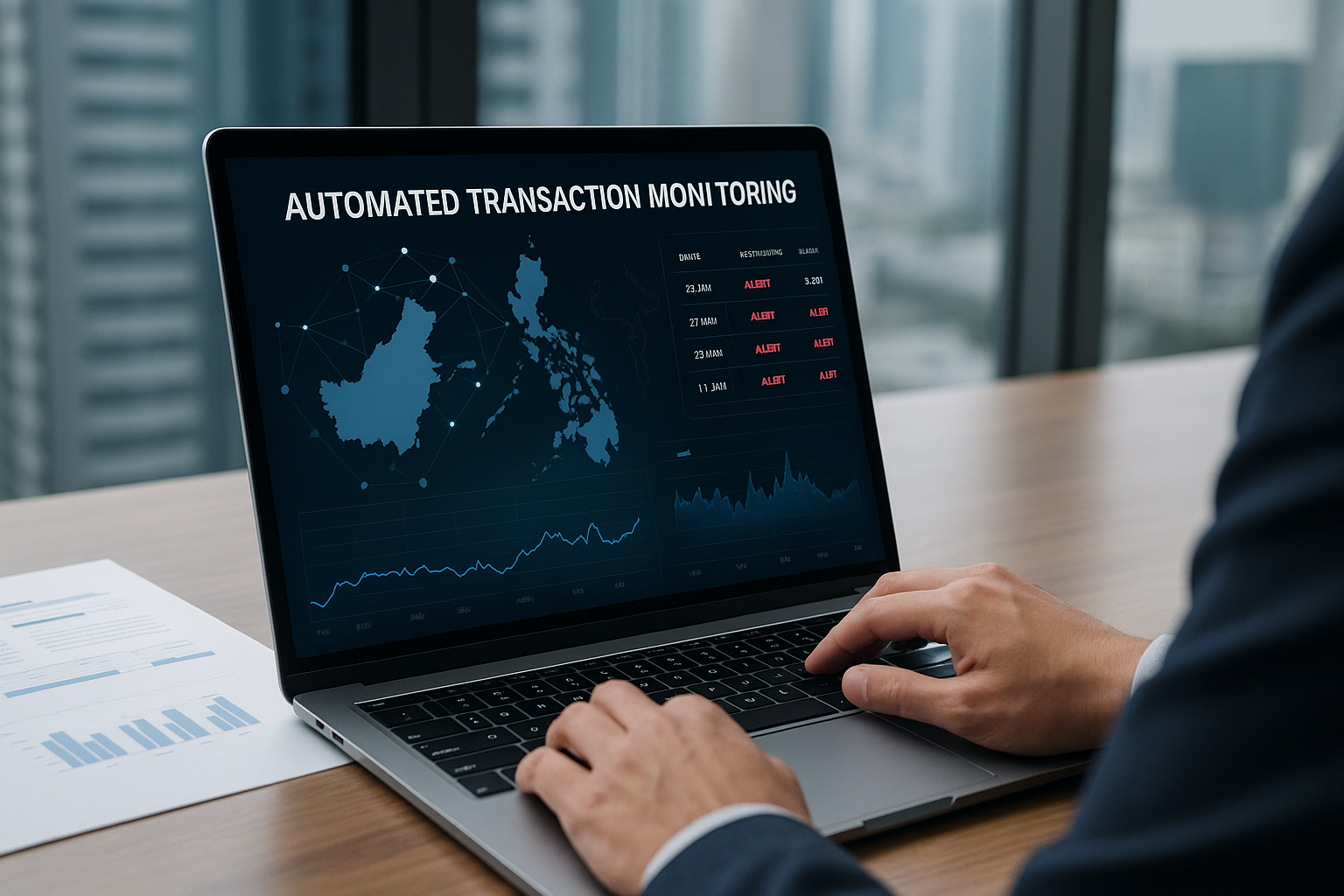Automated Transaction Monitoring: Malaysia’s Next Big Step in Financial Crime Prevention
.svg)
When transactions move in real-time, monitoring them can’t be manual; it has to be automated.
Malaysia’s Digital Finance Boom Comes with New Risks
Malaysia is in the middle of a financial revolution. Digital wallets, instant payments, QR-based transfers, and cross-border remittances are no longer novelties — they are everyday realities for millions of Malaysians. Bank Negara Malaysia (BNM) has been actively pushing the industry towards modernisation while tightening compliance around anti-money laundering (AML) and counter-terrorist financing (CTF).
But as the payments ecosystem accelerates, so does the pace of financial crime. Fraudsters and money launderers are exploiting the very systems designed to improve convenience. From cross-border mule accounts to deepfake-powered scams, Malaysia’s financial institutions are dealing with a wave of threats that move in real time.
This is why automated transaction monitoring is no longer optional — it is the backbone of modern compliance.

The Current Landscape in Malaysia
Malaysia’s regulatory and risk environment underscores the urgency:
- Bank Negara Malaysia’s vigilance — BNM expects banks and fintechs to implement robust monitoring systems, aligned with FATF standards.
- Rising financial crime losses — scams, fraud, and laundering cases have surged, with cross-border syndicates targeting both banks and digital wallets.
- FATF pressures — Malaysia, like many ASEAN nations, faces scrutiny to demonstrate strong AML/CFT controls.
Despite these developments, many institutions still rely on legacy or semi-automated systems. These tools can’t cope with today’s realities of high-volume, high-speed transactions — leaving dangerous gaps in detection.
What Is Automated Transaction Monitoring?
At its core, automated transaction monitoring is a compliance system that uses technology — often AI and machine learning — to monitor financial transactions in real time.
Instead of static rules or manual checks, automated systems:
- Flag unusual activity instantly
- Analyse multiple data points (customer profile, device, geography, frequency, transaction type)
- Apply risk scoring dynamically
- Continuously learn and adapt from new patterns
In a country like Malaysia, where millions of transactions are processed daily across banks, e-wallets, and fintech apps, this automation is the difference between spotting a mule account early or missing it entirely.
Key Features of Automated Transaction Monitoring
An effective automated transaction monitoring system goes beyond alerting. The best solutions typically include:
1. Real-Time Detection
Transactions are monitored as they happen, allowing suspicious behaviour to be flagged before funds can disappear.
2. AI and Machine Learning
Instead of relying solely on fixed rules, AI models identify emerging typologies — for example, new scams targeting retirees or synthetic identity fraud.
3. Risk-Based Scoring
Each transaction is assessed against multiple risk factors. This allows compliance teams to prioritise high-risk cases instead of drowning in false positives.
4. Adaptive Thresholds
Automated systems adjust thresholds based on behaviour and trends, reducing reliance on static limits.
5. Explainability and Auditability
Modern automated systems provide full transparency into why a transaction was flagged, ensuring regulators can trace every decision.
The Limitations of Traditional Monitoring
Why can’t legacy systems keep up? The answer lies in their design. Traditional monitoring solutions are:
- Rule-Based Only — they cannot detect new laundering patterns until rules are manually updated.
- False-Positive Heavy — Compliance teams waste time reviewing thousands of unnecessary alerts.
- Slow — with manual investigations and delays, criminals can layer and withdraw funds before action is taken.
- Fragmented — many banks run separate systems for fraud and AML, creating blind spots across channels.
In short, legacy systems are outmatched by the speed and creativity of today’s financial criminals.

Why Malaysia Needs Automated Transaction Monitoring Now
Several trends make automation urgent in Malaysia:
1. Instant Payments and QR Adoption
Malaysia is leading in QR payment adoption under DuitNow QR. But instant transfers also mean funds can vanish in seconds. Manual checks simply can’t keep up.
2. Mule Account Proliferation
Young adults and low-income individuals are being recruited as money mules. Automated monitoring can spot hub-and-spoke patterns of inflows and outflows, even across institutions.
3. Cross-Border Laundering Risks
Malaysia’s central position in ASEAN makes it attractive for syndicates layering funds through remittances and fintech platforms.
4. Regulatory Scrutiny
BNM expects institutions to demonstrate not just compliance but proactive risk management. Automated monitoring directly supports this.
5. Rising Compliance Costs
Manual investigation and outdated systems increase compliance overheads. Automation offers efficiency without compromising accuracy.
Tookitaki’s FinCense: Automated Monitoring Reimagined
This is where Tookitaki’s FinCense steps in — not as another monitoring tool, but as Malaysia’s Trust Layer to fight financial crime.
Here’s how FinCense sets the benchmark for automated transaction monitoring:
1. Agentic AI Workflows
FinCense uses Agentic AI — intelligent agents that don’t just detect but also triage, narrate, and recommend actions. This means:
- Alerts are prioritised automatically
- Investigations come with auto-generated narratives regulators can understand
- Compliance teams save hours per case
2. Federated Learning: Shared Intelligence, Locally Applied
Through the AFC Ecosystem, FinCense ingests insights from hundreds of institutions across APAC while keeping data private. For Malaysia, this means early detection of scams or laundering patterns first seen in neighbouring markets.
3. End-to-End Coverage
Instead of separate systems, FinCense integrates:
- AML transaction monitoring
- Fraud prevention
- Screening
- Smart disposition tools
This single view of risk eliminates blind spots and reduces costs.
4. Explainability and Governance
FinCense is built with explainable AI, ensuring every flagged transaction is fully auditable and regulator-friendly — critical under BNM’s watch.
5. Proven ASEAN Fit
FinCense’s scenarios are tailored to ASEAN realities — high-volume remittances, e-wallet fraud, QR payments — making it highly relevant to Malaysian institutions.
A Scenario in Action
Consider this example:
- A mule account in Malaysia begins receiving small but rapid inflows from multiple e-wallets.
- Within hours, funds are layered through QR-based merchants and remitted abroad.
- A traditional rules-based system might not detect this until after funds are gone.
With FinCense’s automated monitoring:
- Real-time detection identifies the unusual inflows.
- Federated learning recognises the pattern from similar cases in Singapore.
- Agentic AI prioritises the alert, generates a narrative, and recommends freezing the account.
The result: risk is stopped in its tracks, customers are protected, and compliance officers have clear documentation for regulators.
The Business Impact for Malaysian Banks and Fintechs
Implementing automated transaction monitoring isn’t just about ticking regulatory boxes. It delivers strategic advantages:
- Faster Detection = Safer Customers — protecting consumers from scams builds long-term trust.
- Lower Compliance Costs — automation reduces manual workloads and investigation costs.
- Better Regulator Relationships — explainable AI ensures smooth audits and inspections.
- Competitive Edge — institutions with advanced compliance are more attractive to global partners and investors.
In Malaysia’s increasingly competitive financial services sector, trust is not just a regulatory requirement — it is a business differentiator.
The Road Ahead: Building Malaysia’s Trust Layer
As Malaysia continues to embrace real-time payments, open banking, and digital finance, the risks will only intensify. Manual or outdated monitoring systems simply cannot keep pace.
Automated transaction monitoring is the future — and with solutions like Tookitaki’s FinCense, financial institutions can stay ahead of criminals while reducing costs and strengthening compliance.
For Malaysia’s banks and fintechs, the choice is no longer about whether to automate — but how fast they can adopt an industry-leading trust layer that evolves as quickly as financial crime does.
Experience the most intelligent AML and fraud prevention platform
Experience the most intelligent AML and fraud prevention platform
Experience the most intelligent AML and fraud prevention platform
Top AML Scenarios in ASEAN

The Role of AML Software in Compliance

The Role of AML Software in Compliance









